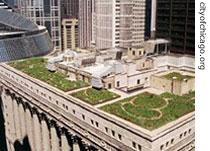VOA慢速英语 2008 0319b
搜索关注在线英语听力室公众号:tingroom,领取免费英语资料大礼包。
(单词翻译)
EXPLORATIONS - Cities Around the World Are 'Going Green'
Here are some ways that local governments are taking steps to protect the environment. Transcript1 of radio broadcast:
18 March 2008
VOICE ONE:
I’m Steve Ember.
VOICE TWO:
And I’m Barbara Klein with EXPLORATIONS in VOA Special English. Today we explore ways in which local governments around the world are working to protect the environment.
 |
| Roof garden on the Chicago City Hall |
These “green cities” are working to reduce energy use and pollution in new and creative ways. Such efforts by city governments not only help reverse2 the effects of climate change. They also help governments save large amounts of money on energy costs. And, cities that are leaders in this green movement set a good example to their citizens about the importance of environmental issues.
(MUSIC)
VOICE ONE:
The Kyoto Protocol3 is an international agreement aimed at reducing the release of harmful gases that are believed to cause climate change. The United States is not part of the agreement. But since two thousand five, over eight hundred American mayors across the country have agreed to sign their own version of the protocol. It is called the Mayors Climate Protection Agreement. Local leaders have agreed to follow the suggestions of the Kyoto Protocol in their communities. These mayors have come together to show how acting4 locally can help solve world problems and protect the environment. "Going green" generally includes saving energy and water, using natural and renewable materials and re-using materials. Here are some interesting ways in which several American communities are "going green."
VOICE TWO:
Eight years ago, officials in Chicago, Illinois, decided5 to replace the black tar6 roof on the city government building with a planted garden. The aim was to reduce energy costs, improve air quality and control the amount of rainwater entering the city’s waste system. Green roofs also help reduce a problem called urban heat islands. During hot weather, the building's tar roof could reach temperatures of up to seventy-six degrees Celsius7. With the garden, the temperature of the roof area was reduced by at least thirty degrees Celsius. Workers planted over one hundred fifty kinds of plants that could survive severe weather. Now, the area is cooler, the building requires less energy to keep cool, and the roof looks nice. Chicago also offers money to help people pay for building their own green roof systems.
VOICE ONE:
The city of Boston, Massachusetts has started developing a plan for a program to make compost fertilizer out of dead leaves, plants and food waste. The gases released from the plant waste would provide the electrical power needed to operate the compost center. After being processed in this environmentally safe center, the compost material could be sold locally. This plan would reduce pollution made by the current waste center and could produce enough electricity to power up to one thousand five hundred homes.
New York City is experimenting with using waves in the East River to create energy. And, in Oakland California, you can ride on one of several public hydrogen-powered buses. These buses release zero pollution into the air. However, they cost five times more than common buses.
VOICE TWO:
Cost is also a major issue in creating "green" buildings and systems. These building materials usually cost more money than normal building materials. But, homeowners are increasingly willing to pay more money to have lower energy costs in the future. And, builders are increasingly offering green building methods as they become more and more important to buyers. Investors8 are also betting on this interest. The National Venture Capital Association says people invested more than two billion dollars in clean technologies last year.
(MUSIC)
VOICE ONE:
Popular Science magazine recently published a list of the fifty “greenest” cities in the United States. Researchers combined information from United States population records as well as the Green Guide made by the National Geographic9 Society.
The list rates cities by looking at their renewable energy sources, transportation programs, recycling efforts and “Green Living” grade. The magazine defined11 Green Living as the number of buildings approved by the United States Green Building Council. This nonprofit organization has a rating12 system for making environmentally safe buildings. It is called Leadership in Energy and Environmental Design, or LEED. According to this list, the greenest city in the United States is Portland, Oregon. San Francisco, California came in second on the list, while Boston, Massachusetts was third. Fourth and fifth were Oakland, California and Eugene, Oregon.
VOICE TWO:
Popular Science researchers used LEED’s rating system to define10 how green a building is. But there are other rating systems as well. For example, the National Association of Homebuilders has its own set of rules. And, the United States Environmental Protection Agency and Department of Energy joined to create the Energy Star program. Energy Star gives ratings13 to devices for the home based on how they use energy. And the program helps homeowners learn how to make changes to their houses in a way that uses energy effectively. Energy Star estimates that in two thousand six it helped Americans avoid the release of harmful gases equal to what twenty-five million cars would produce. And, it says Americans saved fourteen billion dollars on energy costs.
VOICE ONE:
One small town is not yet on any list of the greenest cities. But it may soon be as green as its name. In May of last year, a tornado14 windstorm destroyed most of the town of Greensburg, Kansas. The city decided to rebuild in a better way, using green methods.
 |
| A design by Robert McLaughlin for a green home in Greensburg, Kansas |
Greensburg officials have agreed that all public building projects will follow LEED top-level requirements. The actor Leonardo DiCaprio and the Discovery Channel television station are working together to make a show about Greensburg. The program will show how the people in Greensburg are working to rebuild their town into a green community.
(MUSIC)
VOICE TWO:
Cities around the world are also taking action to protect the environment. For example, the mayor of London, England has made environmental planning an important part of his work. The city has created a Climate Change Action Plan to help cut pollution levels. London has also started a Green Grid15 program in the eastern part of the city. Its aim is to create and protect planted areas in which people can enjoy the outdoors.
In the Netherlands, a Dutch company has built a system that uses cold lake water to cool people’s homes in one area of Amsterdam. This use of a renewable natural resource helps reduce pollution and energy costs.
VOICE ONE:
About five years ago, officials in Thane, India decided to reduce its dependency on power from coal. This city, near Mumbai, often experiences lack of power because of the large numbers of people using electricity. Officials decided to save energy by putting water heaters powered by the sun on top of the city's main hospital. The hospital saved thousands of dollars in energy costs each year. Officials then began building solar powered water heaters around the city. Thane later started requiring solar water heaters for all new buildings. And, the city offers a reduced property tax rate for people who place these water heaters in their homes.
VOICE TWO:
China has announced plans to create an eco-city called Dongtan. The company designing the city says it will produce its energy from the wind, sun and reused waste. The aim is for the city to be an example to the rest of China. China is also working to make the Olympic games this year in Beijing as green as possible. For example, the Olympic Village where athletes and officials live during the games uses solar power technologies and other renewable energy sources.
VOICE ONE:
The United Arab Emirates and the environmental group World Wide Fund for Nature have taken green building a step further with the Masdar City project. Its aim is to be the greenest city in the world. The city will meet environmental rules set by the WWF One Living Planet and the company BioRegional. The city is expected to produce no waste, no carbon pollution and contain no cars. The city will create renewable energy from the wind, sun and other technologies. And, buildings will be made using only recycled materials. Masdar City is expected to be finished by two thousand sixteen.
The United Arab Emirates has given the company Masdar Initiative16 fifteen billion dollars to develop future energy sources. The country aims to become a world leader in renewable energy technologies. Experts say developments like this may lead to a greener future for all cities in the world.
(MUSIC)
VOICE TWO:
This program was written and produced by Dana Demange. I’m Barbara Klein.
VOICE ONE:
And I’m Steve Ember. Join us again next week for Explorations in VOA Special English.
 收听单词发音
收听单词发音 




